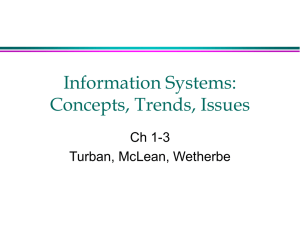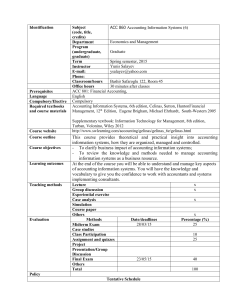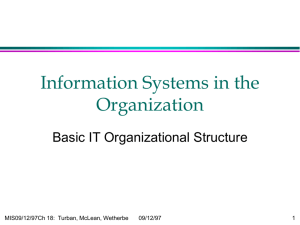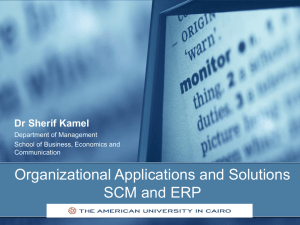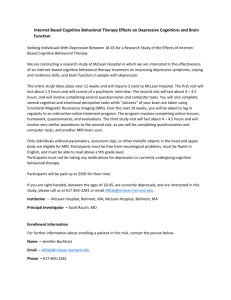Information Systems in the Organization
advertisement
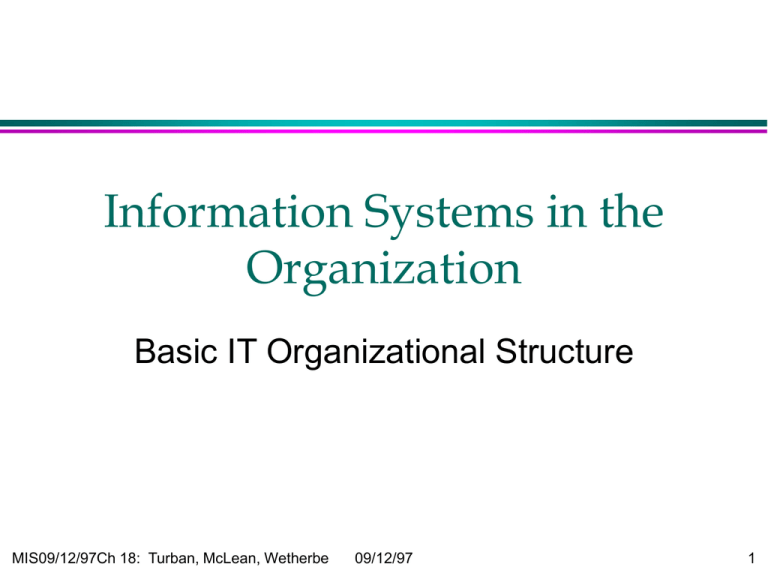
Information Systems in the Organization Basic IT Organizational Structure MIS09/12/97Ch 18: Turban, McLean, Wetherbe 09/12/97 1 It is Not All About Technology Traditional IT Centralized control Resource restrictions Formal methodologies and discipline Careful planning Administrative support MIS09/12/97Ch 18: Turban, McLean, Wetherbe New IT Distributed control Resource expansion Few methodologies and unrestricted access Rapid development Strategic impact 09/12/97 2 Requirements for Successful IT Well understood vision Single team approach Business financial justifications Internal marketing Reengineering skills Political awareness and support MIS09/12/97Ch 18: Turban, McLean, Wetherbe 09/12/97 3 Organization Centralized Decentralized Distributed Consolidation of functions Career paths for IS professionals Information control Economies of scale Closeness to local problems Responsiveness to operational requirements User ownership of costs and problems Separation of IS and user functions Identification of corporate data and functions User ownership of user applications MIS09/12/97Ch 18: Turban, McLean, Wetherbe 09/12/97 4 People MIS09/12/97Ch 18: Turban, McLean, Wetherbe 09/12/97 5 Roles Steering Committee CIO Manager Project Manager Analyst Programmer Systems Programmer User MIS09/12/97Ch 18: Turban, McLean, Wetherbe 09/12/97 6 Centralization, Decentralization or Distribution Centralization • • • • Consolidation of functions Career paths for IS professionals Information control Economies of scale MIS09/12/97Ch 18: Turban, McLean, Wetherbe 09/12/97 7 Centralization, Decentralization or Distribution Decentralization • • • Closeness to local problems Responsiveness to operational requirements User ownership of costs and problems MIS09/12/97Ch 18: Turban, McLean, Wetherbe 09/12/97 8 Centralization, Decentralization or Distribution Distribution • • • Separation of IS and user functions Identification of corporate data and functions User ownership of user applications MIS09/12/97Ch 18: Turban, McLean, Wetherbe 09/12/97 9 IS Organization CIO Development Network Architecture MIS09/12/97Ch 18: Turban, McLean, Wetherbe Operations Data Administration 09/12/97 10 IS Relationship with Users Laissez Faire - no IS involvement Formal - user agreements and contracts Utility - IS supplies standard information resources Vendor - IS promotes solutions in competition with outside competitors Partner - IS and users share common goals and rewards MIS09/12/97Ch 18: Turban, McLean, Wetherbe 09/12/97 11 Rational Management Strategies Train & Retain Train & Replace Layered Skills Restrict & Limit Outsource Entrepreneur MIS09/12/97Ch 18: Turban, McLean, Wetherbe 09/12/97 12 Consultants Access to new ideas and standards Access to additional resources Change agent who can own responsibility MIS09/12/97Ch 18: Turban, McLean, Wetherbe 09/12/97 13 Global Business Drivers • • • • • • • Joint resources Flexible operations Risk reduction Global products Quality Suppliers Corporate customers MIS09/12/97Ch 18: Turban, McLean, Wetherbe 09/12/97 22 Incremental vs Radical Change: TQM vs Reengineering Incremental: Focus on processes to eliminate, rather than correct problems. Radical: Focus on inputs and outputs to completely revise the methods MIS09/12/97Ch 18: Turban, McLean, Wetherbe 09/12/97 23 TQM Total Quality Management • Goals • Measures • Root Causes Total quality management is a cultural change designed to take advantage of the desire of individual workers to do a better job. MIS09/12/97Ch 18: Turban, McLean, Wetherbe 09/12/97 24 TQM W. Edwards Deming & Joseph Juran A philosophy, not a business practice Incremental Process Change Control what you measure Empower employees Prevent rather than correct defects MIS09/12/97Ch 18: Turban, McLean, Wetherbe 09/12/97 25 Reengineering The fundamental rethinking and radical redesign of business processes to achieve dramatic improvements in critical contemporary measures of performance such as cost, quality, service and speed. • Customers: knowledgable and demanding • Competition: continuously increasing • Change: constant MIS09/12/97Ch 18: Turban, McLean, Wetherbe 09/12/97 26 Reengineering Redesign Find new ways to accomplish business goals Retool Create the (IT) systems needed to support the new design Reorchestrate Bring about the organizational changes needed to support the new system. MIS09/12/97Ch 18: Turban, McLean, Wetherbe 09/12/97 27 Principles of Business Process Reengineering • • • • • • • • • Combines jobs Empowers employees Natural and parallel pocess steps Multiple versions of processes Work done where most appropriate Minimal controls, checks and non-value added work Reduce extermal contacts and increase alliances Single point of customer contact Hybrid centralized/decentralized organization MIS09/12/97Ch 18: Turban, McLean, Wetherbe 09/12/97 28 Increment vs Radical Radical Incremental Change Abrupt, volatile Gradual, constant Effects Immediate Long term, subtle Involvement Few champions Culture Investment Orientation High initial, less Low initial, high ongoing ongoing Technology People Focus Profits MIS09/12/97Ch 18: Turban, McLean, Wetherbe Processes 09/12/97 29 Issues • • • • Nurturing creativity and employee participation Planning strategic information systems BPR is major surgery that fails up to 7580% of the time IT changes the ethical environment MIS09/12/97Ch 18: Turban, McLean, Wetherbe 09/12/97 30 Organization MIS09/12/97Ch 18: Turban, McLean, Wetherbe 09/12/97 31
